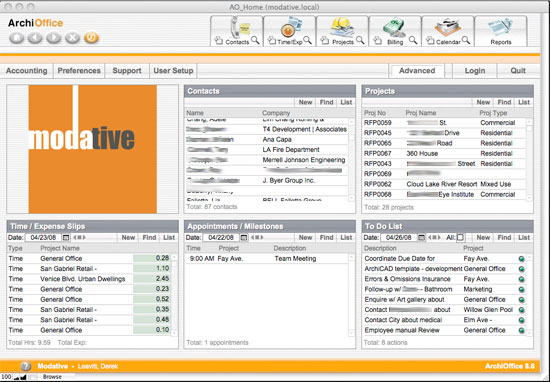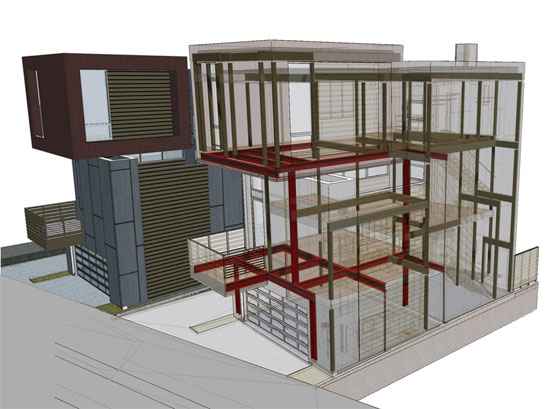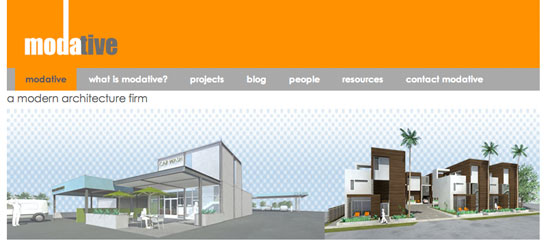Modative's founding partners in front of the Fay 2X Homes. Photo by Dietmar Quistorf
Many thanks to Allison and Dietmar for coming out to interview and photograph us for this piece.design build blog
Modative Featured by University of Southern California
Posted by Derek Leavitt on Tue, Oct 30, 2012 @ 15:10 PM
Tags: Los Angeles, los angeles architects, Architectual Practice, modern architecture firm, Starting an architecture firm, Small Lot Subdivision, Housing
A Modern Architecture Firm's Approach to Organizing Marketing Leads
Posted by Derek Leavitt on Wed, May 2, 2012 @ 06:05 AM
At the tail end of 2010, we realized that the worst of the recession was over for us. Things were getting better. New marketing leads were coming in and we needed to better manage them if we were to take full advantage of this potential increase in business.
As with most small architecture firms, the three principals split up the core roles of running the company. As a principal, one of my roles is marketing manager. So, as 2011 approached, I worked with Christian and Michael to come up with a system for managing leads coming into the office.
When it comes to lead generation, our office is a bit different than most architects in that about 90% of our leads come through our website. So, unlike many older offices that get high probability referral leads, we have to sort through significant noise in our web leads to find the valuable ones. This only increases our need to be more organized.
We began this process by generating two simple diagrams. The first diagram is a simple breakdown of how Modative acquires projects.
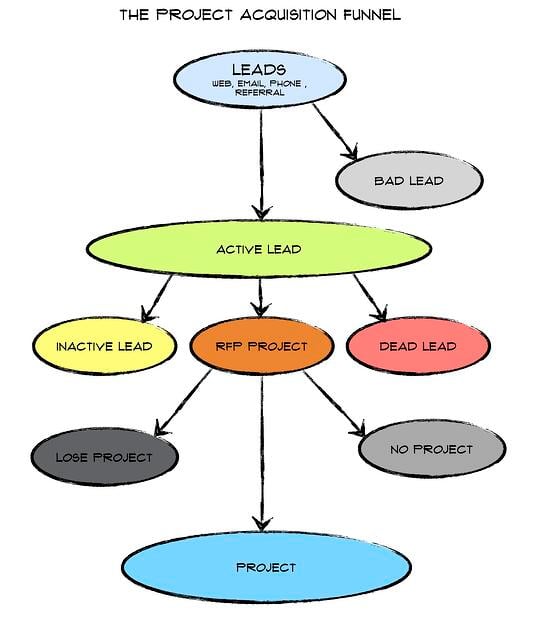
The basic idea in this diagram is that you get leads and filter them down to determine which ones become RFP (Request for Proposal) projects (a small win) and then, after proposals and contracts, which ones become real projects (a big win).
The second diagram describes our process of organizing and managing active leads.
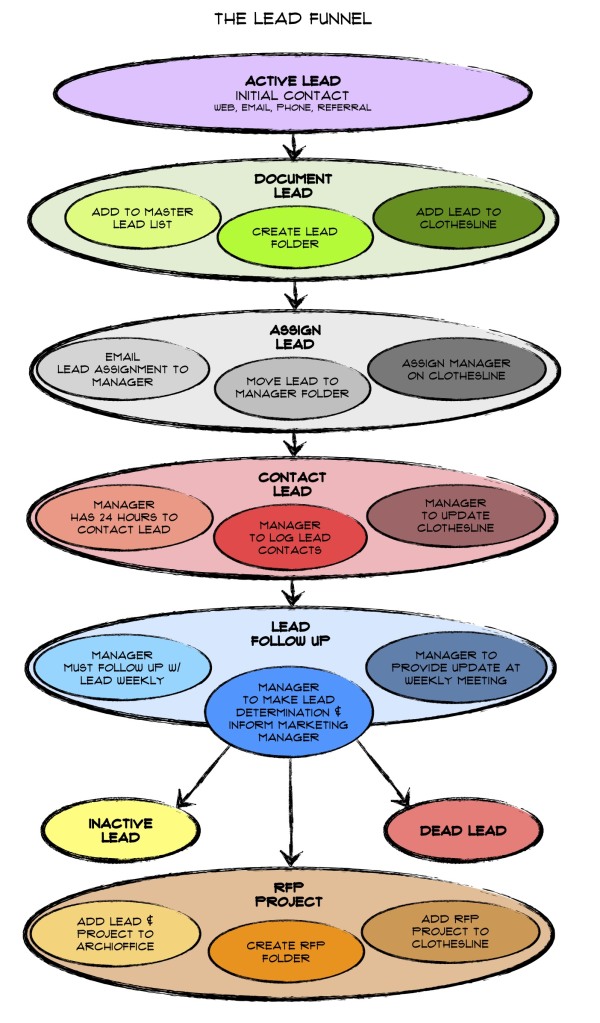
Let's take a closer look at what each step entails.
Document and Assign Lead
1. Add Lead to Master List - This is a simple Excel spreadsheet (we use Numbers, a Mac program) that tracks the basics and is used to give incoming leads a number. Lead numbers begin with an "L" for "Lead" and the last two digits of the year, followed by three digits - L11-001. Here's a sample of the Master Lead List.
| Lead # | Lead Name | Start Date | First Contact Date | Assigned To | Project Type | Lead Type | Notes |
| L11-044 | John Doe | 06.12.11 | 06.13.11 | CDN | SFR | Phone | W. LA Home |
| L11-045 | Jane Smith | 06.18.11 | 06.19.11 | MDS | SLS | Web Form | Venice Beach |
2. Create Lead Folder - Active leads are assigned to managers and the following folder structure is copied into the lead managers folder (on the server) and given the appropriate name - "L11-044 John Doe 06.12.11".

In the "Lead Log and Checklist" folder, there is a word processor file that is filled out with the same info from the Master Lead List and most often, a copy of the the web form data. Below that is a log for the lead manager to keep track of all correspondence with the lead.
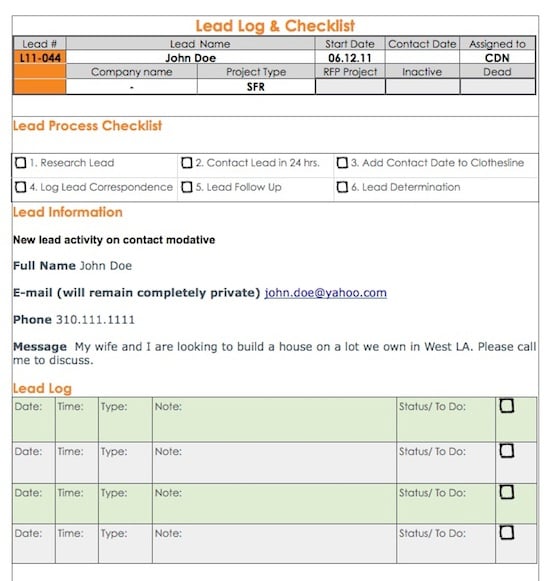
3. Add Lead to Clothesline - If you missed last year's post on "The Clothesline", check it out to see one of the ways we stay organized. Similar to the Master Lead List, the lead info is added via permanent marker (old school, I know) to the Clothesline in the office for everyone to see.
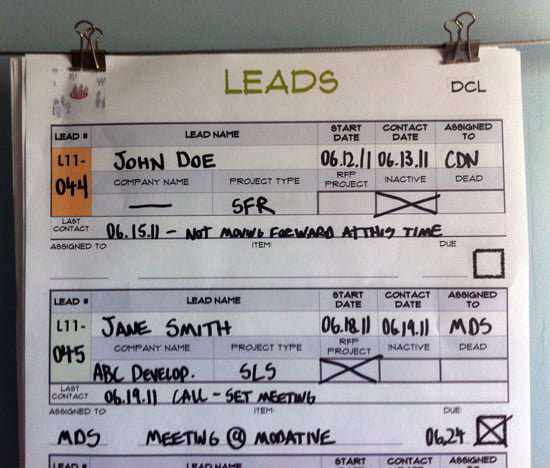
As marketing manger, this provides me with a quick visual on how leads are progressing.
4. Email Lead Assignment to Manger - After the lead has been documented and assigned, we send out a simple email to the lead manager, letting them know that they now have an active lead.
Contact Lead & Follow-Up
1. Initial Lead Contact - It is the lead manager's job to contact the lead within 24 hours and log this contact in both the Lead Log and Clothesline. Most lead managers print out the Lead Log and hand write in the information while on the phone.
2. Lead Follow-up and Determination - After contacting the lead, it is the lead manager's job to determine whether the lead is "Dead", "Inactive" or has the potential to become an "RFP Project". If the lead has potential, the next step is often an in-person meeting. If that goes well, the project graduates to become an "RFP Project" when the potential client asks for a proposal.
3. Weekly Updates - At our regular Monday morning meetings, we review all active leads and managers give a quick update.
Does This Lead Management Process Work?
I'm sure for many, this process seems like overkill. There are several steps and many of them accomplish similar things. But for us, this system has created a series of checks and balances that has worked well versus the alternative of Post-it notes and haphazard internal conversations. No matter how you look at it, without proper lead management, we would be lucky to get any new projects. Besides, any aspect of running our office where we can be more efficient, only leaves us more time to better serve our existing clients.
What systems do you have in place at your office for lead management?
Post by Derek Leavitt. Contributors to this post include Christian Návar, Krystal Návar, and Michael Scott.
Tags: Organization, Architectual Practice, modern architecture firm, architecture resorces, Starting an architecture firm, Marketing
7 Tips for Starting an Architecture Firm - Tip 07: Plan It Out
Posted by Derek Leavitt on Tue, Mar 13, 2012 @ 09:03 AM
This post is part of the How to Start an Architecture Firm series.
In February 2006, Christian, Michael and I went to work on forming our own architecture firm. The following is tip number seven of seven in our start-up strategy.
Side Note: After an almost two year break between Tip 06 and Tip 07, I thought it was about time to wrap up this series. We've had an interesting two years, surviving the recession and emerging as a viable and busy architecture firm. Enjoy!
Tip 07: Plan It Out
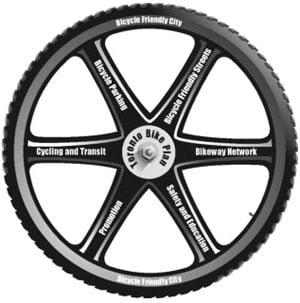
When architects dream of running their own firms, they often flash right to the fun stuff:
What types of buildings will we design?
What will our design philosophy be?
While these are important questions, it's important to design your business with equal thought. When I think back to Modative's founding, I don't think as much about that actual first day of being out on our own as much as the six months leading up to the launch. During this time, we met once a week to hash things out while still working our day jobs for other architecture firms. Because the three of us lived in the three corners of Los Angeles, we would either meet online (thanks ichat) or we would drive to USC at night (where we all had gone to school) and sneak into a classroom at the VKC building.

The VKC @ USC. Photo taken by Bobak Ha'Eri, on May 27, 2007
It was important to determine certain things before we all quit our day jobs. We didn't meet to create some exhaustive business plan that no one would read, but to determine general goals and strategies for the company. If you don't establish a grander vision from the start, two things are likely to happen:
1. You'll get too busy doing actual work (projects) and your firm will operate without a vision. This is like designing a project without clear goals or concepts: it can be done, but it doesn't lead to a great product.
2. You'll have no way to measure at whether you've been successful in achieving your goals.
One of the ways we got organized was to develop a strategic plan. The first step in that process was a SWOT analysis. SWOT is an acronym for Strengths, Weaknesses, Opportunities, and Threats. Here was our original SWOT analysis from 2006:
SWOT Analysis
Internal |
External |
Strengths |
Opportunities |
|
1.creativity 2. team approach 3. design ability 4. “technology” 5. organizational ability 6. diversity 7. presentation 8. leadership 9. network
|
1. former employers 2. large/ diverse residential pool 3. location - los angeles 4. network-friends and family 5. real estate agents, contractors 6. development projects 7. building possibly 8. “non-architecture” projects 9. diversity of los angeles 10. money in los angeles 11. music, movie, sports industry 12. “housing buble” burst 13. having lower fees |
Weakness |
Threat |
|
1.not having “own” portfolio 2. no professional license 3. weak “field” const. experience 4. no infrastructure (equipment) 5. other than type “V” construction 6. staff quantity 7. experience/ age 8. inefficient staff-to-principle ratio 9. publicity 10. financial resources 11. credit worthiness |
1.other capable firms 2. “housing bubble” burst 3. # of firms in los angeles 4. general misperception of no need for architect 5. major markets outside of los angeles 6. having lower fees 7. lack of credit and cash
|
Looking back after six years of being in business, many of these initial SWOT assumptions were correct. Over the years we've been able to take advantage of our strengths and opportunities, while reducing the weaknesses and threats. In the end, developing a strategic plan was easy -the final document was only five pages long.
Choose Your Partners Carefully
If you have business partners, this planning process is even more critical to determine if you and your partners share the same values. We all knew each other since our early days at USC, but just as important, we had overlapping work experience prior to starting Modative, meaning that we had worked together professionally prior to starting our firm. Here's a diagram we posted on our website back in 2006 showing our experience overlap.

Now that we've shared Modative's founding story, it's time to begin your story.
Use the navigation below to get caught up on all of our 7 Tips for Starting an Architecture Firm.
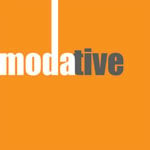 |
7 Tips for Starting an Architecture Firm |
 |
00 BootstrappingNot a tip, but a critical theme in our start-up adventure. posted 12.03.09 |
 |
01 Be Cheapposted 12.08.09 |
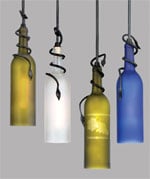 |
02 DIY (Do It Yourself)posted 12.18.09 |
 |
03 Get Adviceposted 12.22.09 |
 |
04 Learn from the Badposted 01.22.10 |
 |
05 Start and Stay Smallposted 03.03.10 |
 |
06 Stay Flexibleposted 04.05.10 |
 |
07 Plan It Outposted 03.13.12 |
The bad news is that this is the last of the 7 Tips to Starting an Architecture Firm. The good news is that we're learning and posting new tips all the time.
Stay up-to-date by subscribing to this blog by adding your email to the subscribe form. Or, if you're a technocrat, you can grab our rss feed.
Tags: Los Angeles, los angeles architects, Inspiration, Communication, Architectual Practice, architecture resorces, Starting an architecture firm
7 Tips for Starting an Architecture Firm - Tip 06: Stay Flexible
Posted by Derek Leavitt on Mon, Apr 5, 2010 @ 08:04 AM
This post is part of the How to Start an Architecture Firm series.
In February 2006, Christian, Michael and I went to work on forming our own architecture firm. The following is tip number six of seven in our start-up strategy.
Tip 06: Stay Flexible

Starting your own architecture firm is not a settling experience. It's not glamorous.
There are many implications to being a flexible company, but I'm going to focus on our flexibility with regard to physically moving our office.
Office 01
As mentioned back in Tip 01, we started our firm in Michael's basement. We didn't have money for fancy furniture. We could only afford IKEA. This turned out to be a blessing.
Our IKEA desks are simple. The $20 laminate table top is sold separate from the $4 metal legs. After a few minutes mounting the leg brackets with a drill, the legs screw right into the table top. Equally important, the legs unscrew, without tools, in about 30 seconds. A genius design, especially considering that we moved into our fourth office space by the time our company was 40 months old.
IKEA Vika Amon table top and Vika Curry legs
Office 02
After a few months in Michael's basement doing start-up stuff and completing our first few jobs, we had enough money for a real office. Well, not a real office, but a small office suite in a tower by the airport. The conference room was shared with other businesses on our floor. Our office suite looked right out on the 405 freeway (see picture 02 below).
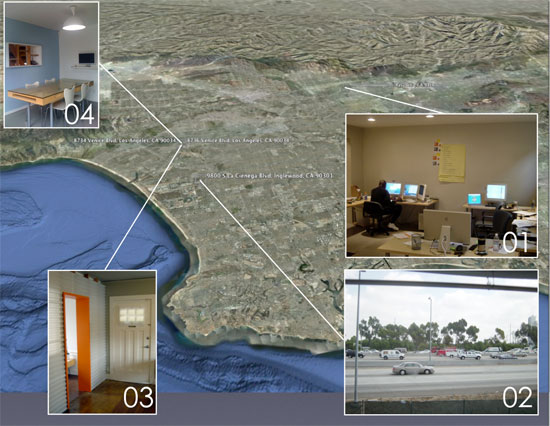
Our four offices in 40 months overlaid on a map of Los Angeles.
Office 03
Our third office space, as touched upon in Tip 02, was a converted old house located on a commercial property. The property was the future site of a project we were designing, the Venice Boulevard Urban Dwellings. We worked out free rent as part of our design fee.
Office 04
When that project was put on hold as a result of the housing market collapse, we had to move next door into a commercial building. Rent wasn't free anymore. The space required some upgrading, but nothing like what we went through with the old house. We're still here and it's working well for us.
One way we maintained consistency was to get a mailbox in our first month of operation. We opted for a UPS mailbox near where I live. We still have the mailbox, which is a small price to pay for staying flexible. One less obstacle to moving the office quickly.
While I never expected to be moving so much, we always had a positive mindset. Each move was not only a physical upgrade, but an opportunity to rethink our internal organization. Keeping things fresh.
Stay tuned as we fill in the final tip of our 7 Tips for Starting an Architecture Firm.
 |
7 Tips for Starting an Architecture Firm |
 |
00 BootstrappingNot a tip, but a critical theme in our start-up adventure. posted 12.03.09 |
 |
01 Be Cheapposted 12.08.09 |
 |
02 DIY (Do It Yourself)posted 12.18.09 |
 |
03 Get Adviceposted 12.22.09 |
 |
04 Learn from the Badposted 01.22.10 |
 |
05 Start and Stay Smallposted 03.03.10 |
 |
06 Stay Flexibleposted 04.05.10 |
 |
07 Plan It Outposted 03.13.12 |
Tags: Los Angeles, Architectual Practice, Starting an architecture firm
7 Tips for Starting an Architecture Firm - Tip 05: Start and Stay Small
Posted by Derek Leavitt on Wed, Mar 3, 2010 @ 05:03 AM
This post is part of the How to Start an Architecture Firm series.
In February 2006, Christian, Michael and I went to work on forming our own architecture firm. The following is tip number five of seven in our start-up strategy.
Tip 05: Start and Stay Small

I've never been a fan of large companies. It's probably because I've never worked for one. Before founding Modative, I worked for three small- to medium-sized architecture firms. Christian and Michael have similar experiences, learning the architecture business in offices where you had to do it all. There was no way to pass along unwanted tasks or hide amongst hordes of CAD stations.
Christian always jokes that in one office, the first thing the boss asked him to do on his first day was to take out the trash. Experiences like this are humbling, but also critical to developing the kind of discipline it takes to start your own architecture firm.
If I don't do this myself, it won't get done.
A philosophy that clearly ties into Tip 02: Do it Yourself.
Growing a Company on Fact vs. Faith?
Many people set out on their own with intentions of growing their offices fast. Far too often, this growth is unwarranted.
Are you hiring people because you can't possibly complete your long-term billable work with your current staff?
Or, are you hiring in a panic because you momentarily feel overwhelmed at a perceived inundation of new projects in the office?
Even worse, are you hiring so you can tell people at dinner parties that your office has X number of people or so you don't have to work more than 40 hours a week?
We have faced all of these situations here at Modative. To expand or not to expand. I credit our frequent internal debates amongst my partners and I to keeping our company small and responsible when it comes to hiring.
It would have been far too easy in our founding year (2006) to grow our company based on faith in the booming economy. But as this glimpse of the U.S. stock market shows over our first three years in business, we made the right call to base our growth on fact rather than faith.

Technology Enables "Smallness"
When I graduated from architecture school 10 years ago, most firms were organized in a much different fashion. Architecture offices relied on larger project teams to complete the labor-intensive production and coordination that 2D CAD (and even some hand drafting) required. As technology improved, these old-school firms had a tough time changing. Their principals, often from a generation that didn't grow up with computers, would eventually come to embrace new technology, but in a slow evolutionary way, dragged down by large production-based staffs. It has taken 10 years for many of these old-school firms to evolve into technology. Many of them still resist.
Having three founders that grew up with computers and rapid technology changes, our firm was founded with a much different mentality. We embrace technology because it enables us to remain small. Our new-school firm can accomplish the same amount of work with one person that an old-school firm needed 4-8 people to complete. These two technologies help make this possible:
ArchiOffice
This program is the key to keeping us organized. It's a management system for our projects, contacts, time cards, calendar, billing and much more. Check out a prior post where I describe our ArchiOffice use in more detail.
A screenshot of the ArchiOffice dashboard.
ArchiCAD
I've worked with ArchiCAD, our CAD software here at Modative, on and off for nine years. ArchiCAD's BIM (building information modeling) technology enables "smallness" by taking much of the grunt work out of drawing production, allowing us to focus on creativity. Virtually constructing projects before they are built not only creates pretty pictures to show our clients, but it also drastically reduces expensive construction conflicts.
An example of how our virtual building models contain information on the structural systems, reducing potential drawing errors.
Stay tuned as we fill in the last two tips of our 7 Tips for Starting an Architecture Firm.
 |
7 Tips for Starting an Architecture Firm |
 |
00 BootstrappingNot a tip, but a critical theme in our start-up adventure. posted 12.03.09 |
 |
01 Be Cheapposted 12.08.09 |
 |
02 DIY (Do It Yourself)posted 12.18.09 |
 |
03 Get Adviceposted 12.22.09 |
 |
04 Learn from the Badposted 01.22.10 |
 |
05 Start and Stay Smallposted 03.03.10 |
 |
06 Stay Flexibleposted 04.05.10 |
 |
07 Plan It Outposted 03.13.12 |
Tags: Architectual Practice, Construction Conflicts, Innovation, Software, Business, architecture resorces, Starting an architecture firm
7 Tips for Starting an Architecture Firm - Tip 04: Learn from the Bad
Posted by Derek Leavitt on Fri, Jan 22, 2010 @ 06:01 AM
This post is part of the How to Start an Architecture Firm series.
In February 2006, the three of us went to work on forming our own architecture firm. The following is tip number four of seven in our start-up strategy.
Tip 04: Learn From The Bad

As every aspiring architect leaves school, they are faced with an important decision, "Where should I work?" This is a tough decision. Go work for a big corporate firm and risk getting stuck on one project for several years or go for a small design-oriented firm and miss out on some of the business savvy of a larger firm?
Although this is an obvious over-simplification of architecture firm types, many young professionals fret over this decision.
When I graduated from USC, Michael (fellow Modative partner) and I went to work for a medium-sized (8-15 people) sized firm in Santa Monica, CA called David Jay Flood Architect. My experience at this firm was invaluable. I was given a high level of responsibility managing large projects at a young age. I did a lot of learning on the job.
After three years at that firm, I moved on, working for two more firms before founding Modative with Michael and Christian in 2006. In my time working for other people I learned plenty of good architecture industry practices, but I also learned a lot of what not to do. I call this "learning from the bad."
So while my experience involved working for small- and medium-sized firms, I've come to realize that the type of firm(s) you work for is less relevant than what you gain from the experience. Learning from the bad is a big part of this. Learning what to do and what not to do are inextricably tied. If you never give yourself the opportunity to learn what not to do by watching other people work, you're more likely to make those mistakes when you're running your own firm
Whether you don't like the way your boss manages projects or you made a big mistake on a set of plans, you will no doubt encounter plenty of negative situations working for others. These bad experiences are invaluable when you decide to start your own firm. File them away for when you're the boss and have to decide how to run your firm.
So, when the time comes to start your firm, will you make the same mistakes or will you learn from the bad?
Stay tuned over the next several weeks as we fill in the last three tips of our 7 Tips for Starting an Architecture Firm.
 |
7 Tips for Starting an Architecture Firm |
 |
00 BootstrappingNot a tip, but a critical theme in our start-up adventure. posted 12.03.09 |
 |
01 Be Cheapposted 12.08.09 |
 |
02 DIY (Do It Yourself)posted 12.18.09 |
 |
03 Get Adviceposted 12.22.09 |
 |
04 Learn from the Badposted 01.22.10 |
 |
05 Start and Stay Smallposted 03.03.10 |
 |
06 Stay Flexibleposted 04.05.10 |
 |
07 Plan It Outposted 03.13.12 |
Want to stay up to date as we post the 7 Tips to Starting an Architecture Firm? Subscribe to this blog by adding your email to the subscribe form on the right.
Tags: Los Angeles, los angeles architects, architect advice, Architectual Practice, Starting an architecture firm
Advice as a Marketing Opportunity for Young Architects
Posted by Derek Leavitt on Tue, Jan 5, 2010 @ 09:01 AM
As a follow-up to our last post, 7 Tips for Starting an Architecture Firm - Tip 03: Get Advice , I thought I'd touch on a related marketing strategy, a big secret:
Aside from gaining valuable information, your start-up advisers are also your best marketing source.
When starting an architecture firm, trust can be difficult to attain. This is especially true if, like us, you start your firm at a relatively young age. When you launch, you'll have very little to show potential clients. So while you can and should show potential clients work you completed while working for other firms (see How a Young Architecture Firm Can Show Its Experience), in all likelihood, your first projects will come from people you have a prior relationship with - such as the people you're asking for advice.
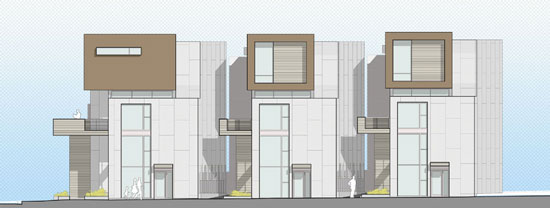 Just thought this post could use a pretty picture. It was either this or a cheesy stock photo of business people shaking hands.
Just thought this post could use a pretty picture. It was either this or a cheesy stock photo of business people shaking hands.
Asking for advice is a great way to meet with people, let them know you're starting your own business, and gain their trust, all while not seeming like you're looking to gain anything other than free advice. So while marketing your new firm may be secondary to getting advice, there's a good chance you may get some projects out of it. We did.
Tags: Architectual Practice, Architecture Experience, Starting an architecture firm, Marketing
7 Tips for Starting an Architecture Firm - Tip 03: Get Advice
Posted by Derek Leavitt on Tue, Dec 22, 2009 @ 08:12 AM
This post is part of the How to Start an Architecture Firm series.
In February 2006, the three of us went to work on forming our own architecture firm. The following is tip number three of seven in our start-up strategy.
Tip 03: Get Advice

After nearly four years in business, I can say with great certainty that we wouldn't have survived more than a year without getting great advice from some key people.
Asking for advice is easy. People love to give advice and share their success stories.
Our advice came from the following four groups:
1. Family
Aside from getting your family on board with the idea of you going out on your own, you should also get their advice. There's a good chance that at least one person in your family has started their own business.
2. Friends
While we received great business advice from many of our friends, there are two in particular that stand out:
|
Sam Sam is an entrepreneur. The three of us went to USC with Sam. And while we were drawing and building models over in architecture school, Sam was in business school learning to be an entrepreneur. Actually, Sam had always been an entrepreneur. It's in his blood. There's a rumor that as a child, he outsourced his chores to other kids in the neighborhood, maintaining a cut for himself. When his Mom found out, she was too proud to punish him. |
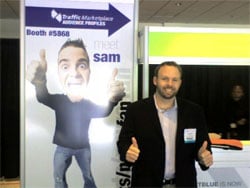 Sam will likely kill me for profiling him on our blog. Sam will likely kill me for profiling him on our blog. |
By the time we formed Modative, Sam was on his third business start-up. He advised us to be cheap (see Tip 01) and to do much of the start-up work ourselves (see Tip 02), such as forming our own corporation. Sam also got us started on internet advertising years before the bulk of the architecture industry caught on.
The fact that Sam is not an architect was actually an asset. He taught us to question norms within the industry. Sam continues to push us today.
|
Jon Jon is another good friend from USC. Jon is a lawyer. He lives in Northern California. While in Tip 02: DIY, I recommended to avoid hiring a lawyer, as our business grew, we found ourselves needing legal advice on contracts and other minor items. Instead of hiring an attorney, we've asked Jon for advice. In return for his help, he always has a place to stay when he frequently visits Los Angeles. And when the time comes for Jon to build his own house, he'll cash in all those favors. If you'd like Jon to be your lawyer, he can be found here - Tingley Piontkowski LLP Jon will probably also be less than pleased that I've profiled him on our blog. Now we'll need a new lawyer friend to defend us in a lawsuit from our first lawyer friend.
|
 |
3. Network
Guessing and gut instinct are not good business strategies. Finding an expert or someone who's been there before will dramatically increase your rate of success. Beyond your family and close friends, there's a network of people that can help you with just about anything.
Need advice on web design? Chances are you know, or your friends know, someone that is a master web designer.
4. Competitors
Overall, I would say that the architecture industry is pretty amicable. Advice flows freely. We used this to our advantage early on, meeting with established architects that would later become our competitors. The idea was not to steal from them, but to learn from them.
Since then, we've met with numerous younger professionals trying to start their own firms. We share with them (and now you) like other firms shared with us, knowing full well that they might become our competitors in the future. A full circle of idea sharing.
Stay tuned over the next several weeks as we fill in the last four tips of our 7 Tips for Starting an Architecture Firm.
 |
7 Tips for Starting an Architecture Firm |
 |
00 BootstrappingNot a tip, but a critical theme in our start-up adventure. posted 12.03.09 |
 |
01 Be Cheapposted 12.08.09 |
 |
02 DIY (Do It Yourself)posted 12.18.09 |
 |
03 Get Adviceposted 12.22.09 |
 |
04 Learn from the Badposted 01.22.10 |
 |
05 Start and Stay Smallposted 03.03.10 |
 |
06 Stay Flexibleposted 04.05.10 |
 |
07 Plan It Outposted 03.13.12 |
Want to stay up to date as we post the 7 Tips to Starting an Architecture Firm? Subscribe to this blog by adding your email to the subscribe form on the right.
Tags: Los Angeles, los angeles architects, architect advice, Architectual Practice, Starting an architecture firm
7 Tips for Starting an Architecture Firm - Tip 02: DIY
Posted by Derek Leavitt on Fri, Dec 18, 2009 @ 09:12 AM
This post is tip number two of seven in our How to Start an Architecture Firm series, a look into Modative's founding in 2006.
Tip 02: DIY (Do It Yourself)
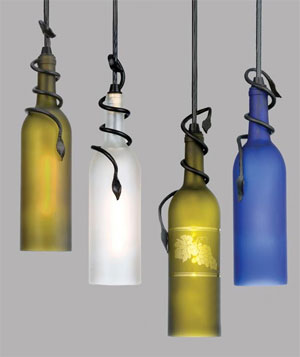
During our architecture firm start-up, one of the ways were able to be cheap was to do almost everything ourselves. Here are five key things that we did ourselves in order to save money:
1. Filing a CorporationLawyers are expensive. And, unfortunately, many people feel they must hire one in order to start a business. This is simply not true. Setting up a business structure is actually quite easy to do yourself. There are numerous affordable resources to help you avoid hefty legal fees. There's the online legal document service, legal zoomthat can help you set up your firm's business structure for a few hundred dollars. Modative, however, went an even cheaper route and purchased a do-it-yourself book (pictured right) from Nolo at the local book store. The book comes with a CD-ROM that has all of the templates you'll need in MS Word format. |
Even if you're not sure which business legal structure is right for you: Corporation, Partnership or LLC, Nolo has books to help you decide. Just remember that every state is a bit different and some states don't permit certain legal structures for architecture firms.
If you have partners, you'll also need to set up a business buyout agreement, also known as a "business prenup".
So now that you know how easy and cheap it is to set up a proper business structure, there are no excuses not to do it. Not going through this simple process is a huge liability, especially in the architecture field.
2. Company GraphicsThis is probably a no-brainer for most architects. We are designers after all. Now is your chance to use those non-architecture design skills to help build your business brand with graphics. Here at Modative, we did, and continue to do all of our own graphics, from business cards to marketing materials. Oh, and yes, we like orange. Though this process, we also learned that we enjoy doing graphics so much that Modative now offers these services to our clients.
|
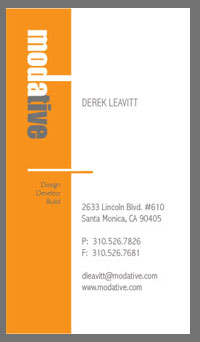 |
3. Website
In line with doing your own graphics, there's never been an easier time to make your own website. We created and maintain our own website without any programming knowledge. Many architects tend to over-complicate their websites with outsourced, fancy flash sites, when a simple do-it-yourself HTML site is easier for potential clients to navigate.
4. Architecture Grunt Work
Anyone with professional experience in the architecture field knows that there's plenty of grunt work to go around. Starting your own firm will place all of this undesirable work at your feet. If you want to keep your firm financially viable at the start, hiring staff should be your last resort.
To minimize architecture-related grunt work, we implemented ArchiCADas our CAD software. Since all three partners had used it before and even owned a few copies, it was the logical choice. Besides, BIM (Building Information Modeling) programs such as ArchiCADenable small teams of experienced users to accomplish a lot of work with much less of the grunt work associated with (old technology) 2D CAD programs.
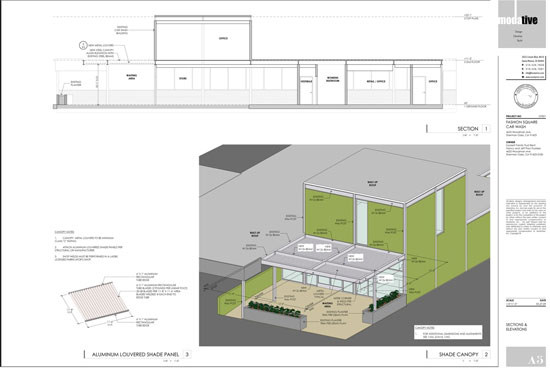
The above example shows how our software enables us to efficiently generate easy-to-read 3D drawings and technical 2D drawings within the same program. This leads to more time for design, less time on grunt work.
5. Office Improvements
Since our founding office in Michael's basement, we've moved our office several times (more on this in Tip 06). In a few of these moves, we've had to improve less-than-desirable spaces to make them usable for us and presentable to our clients. Without funds to hire a construction crew, we were left to do the labor ourselves.
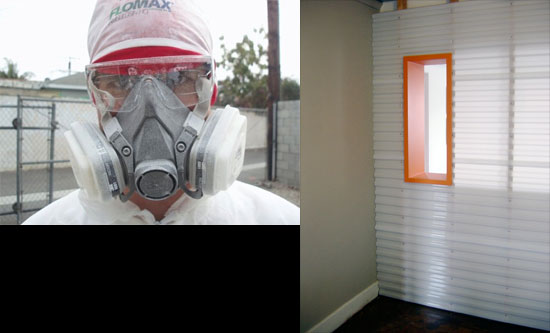
In our third office space, we took a break from architecture to do a little construction and painting. The image above (left) is of me in full gear, ready for some paint spray gun action. Above right is a feature wall that Michael and Christian constructed in that same office.
Although the do-it-yourself approach can be testing at times, it allowed us to acquire new skills and learn from these often rewarding experiences.
Stay tuned over the next several weeks as we fill in the last five tips of our 7 Tips for Starting an Architecture Firm.
 |
7 Tips for Starting an Architecture Firm |
 |
00 BootstrappingNot a tip, but a critical theme in our start-up adventure. posted 12.03.09 |
 |
01 Be Cheapposted 12.08.09 |
 |
02 DIY (Do It Yourself)posted 12.18.09 |
 |
03 Get Adviceposted 12.22.09 |
 |
04 Learn from the Badposted 01.22.10 |
 |
05 Start and Stay Smallposted 03.03.10 |
 |
06 Stay Flexibleposted 04.05.10 |
 |
07 Plan It Outposted 03.13.12 |
Want to stay up to date as we post the 7 Tips to Starting an Architecture Firm? Subscribe to this blog by adding your email to the subscribe form on the right.
Tags: Los Angeles, los angeles architects, architect advice, Architectual Practice, Starting an architecture firm
7 Tips for Starting an Architecture Firm - Tip 01: Be Cheap
Posted by Derek Leavitt on Tue, Dec 8, 2009 @ 09:12 AM
This post is part of the How to Start an Architecture Firm series.
In February 2006, three guys in their late 20's quit their day jobs and went to work on forming their own architecture firm. The following is tip number one of seven in their start-up strategy.
Tip 01: Be Cheap

How much money do you think it requires to start an architecture firm?
Most people would probably guess in the tens of thousands of dollars or more. This certainly was not the case with Modative. We began with $500 per partner: $500 that was more of a formality to purchase our company stock.

So how is this possible?
For starters, our first office wasn't really an office, but Michael's basement in suburban Pasadena, CA. Needless to say, it was rent-free. And although it was a 16-step commute for Michael, Christian and I had long traffic-filled drives from Los Angeles's west side.
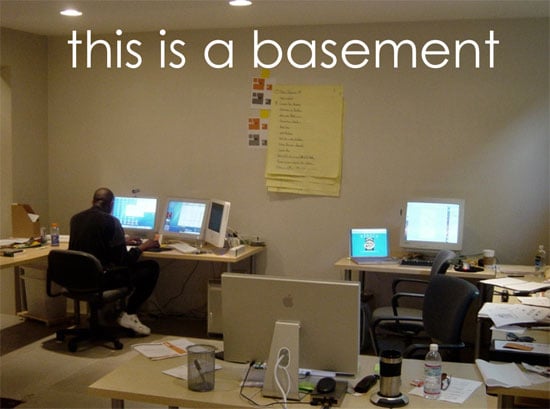
As you can see, we had some decent equipment. But we didn't buy anything except for a few ikea desks, chairs and some minimal office supplies. We used the computers, printers and software we already used personally or could scrounge up from relatives (Thanks Dad).
Our goal was to never spend money we didn't have. Although we had a few (low-limit) company credit cards, we kept expenses light. This was especially critical because we started the firm without any projects or other sources of revenue.
After a few months, Modative's first project came about as an independent consultanting job for a friend's father's architecture firm.

The project (above) was a ground-up office and warehouse for a tile manufacturer. It wasn't the most glamorous project, but it was essential to helping us build some momentum as a real business.
One of the other ways we were able to be cheap will be revealed in the forthcoming Tip 02.
Stay tuned over the next several weeks as we fill in the blanks on our 7 Tips for Starting an Architecture Firm.
 |
7 Tips for Starting an Architecture Firm |
 |
00 BootstrappingNot a tip, but a critical theme in our start-up adventure. posted 12.03.09 |
 |
01 Be Cheapposted 12.08.09 |
 |
02 DIY - Do It Yourselfposted 12.18.09 |
 |
03 Get Adviceposted 12.22.09 |
 |
04 Learn from the Badposted 01.22.10 |
 |
05 Start and Stay Smallposted 03.03.10 |
 |
06 Stay Flexibleposted 04.05.10 |
 |
07 Plan It Outposted 03.13.12 |
Want to stay up to date as we post the 7 Tips to Starting an Architecture Firm? Subscribe to this blog by adding your email to the subscribe form on the right. We never spam our fine followers and if later on discover you're completely over us, you can easily unsubscribe.
Tags: Los Angeles, los angeles architects, architect advice, Architectual Practice, Starting an architecture firm




